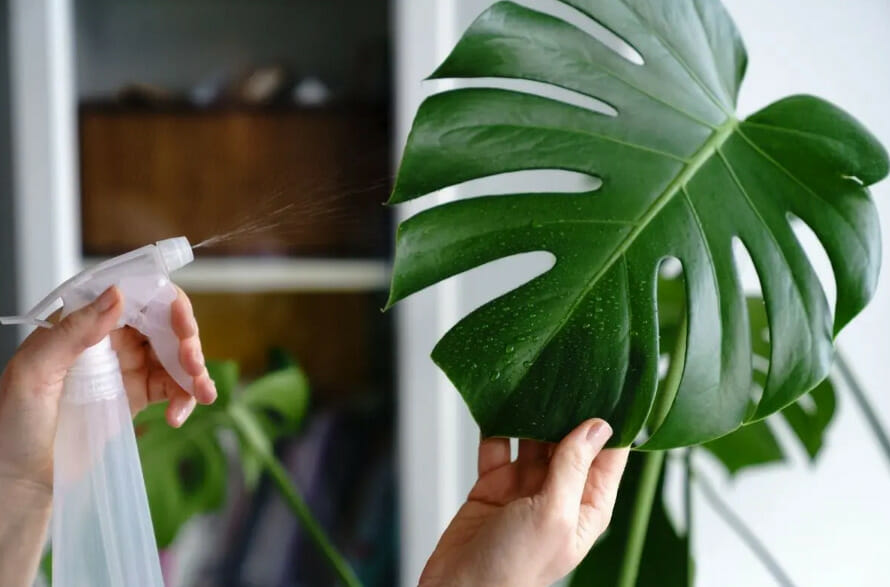Monstera deliciosa, commonly known as the swiss cheese plant, is a beautiful and popular houseplant. Swiss cheese plants are distinguished by their extensive, shiny heart-shaped leaves. If you are looking to grow a plant for your garden or your house, then there is no better option than swiss cheese plants. It will not only add to the beauty of your house but will also freshen the air. However, if you are new to gardening or you don’t know much about Monstera Deliciosa, then worry no more! This blog provides complete information on Monstera Deliciosa care indoors.

Without further wait, let’s dive in!
1. Facts:
| Botanical Name | Monstera deliciosa |
| Family | Araceae |
| Type | Indoor/outdoor plant |
| Height | 10 to 15 indoors |
| Exposure | Bright indirect sunlight, partial shade |
| Soil | Well draining |
| Toxicity | Toxic to cats and dogs |
2. About Monstera Deliciosa
Before growing a plant on your own, it is better to research it first. Monstera Deliciosa is a lush flowering plant that originated in southern Mexico. The plant has holes in the leaves that it gets during the process of fenestration. Fenestration is the process when monstera starts to grow new leaves with holes. Young leaves don’t fenestrate, it usually takes 2-3 years for the leaves to fenestrate.
The holes in the leaves resemble swiss cheese which is why it is commonly known as the swiss cheese plant. When grown outdoors, this tropical plant can reach a height of 66 feet, but when grown indoors, it only grows between 6 to 9 ft.
2.1. Propagating Monstera from Cutting
The quickest and easiest way to grow cheese plants is by the cutting method. All you have to do is to take cuttings from a pre-growing swiss cheese plant and place them in a new pot. But how to do it properly?
Step 1: First of all, you are going to need a sharp knife. Make sure to use the knife properly to avoid any kind of incident. The question is, where to cut? You cannot just take cuttings from wherever you want.
Step 2: To take cuttings from the plant, use your knife to cut from the nodes. You might be wondering what the nodes are. The node is the portion of the parent plant’s stem where the stalk (petiole) connects. In simple words, if you spot two or more leaves coming out from a point, that is a node.
Step 3: Cuttings can be placed directly in the soil, or you can also soak them in water for almost 3 weeks.
Step 4: If you choose to soak them in water, then make sure you change the water regularly to avoid mold formation.
Step 5: The new roots and leaves will emerge after some days.
Step 6: When you notice that the roots start growing it’s time to place them in their new home! Now carefully transplant your newly grown swiss cheese plant into a new pot mixing having quality soil.
Now that you have successfully grown a Monstera, all you have to do is to take care of it. Do not worry it is a low-maintainence plant. So, get ready for a few quick tips!

Related Article: How to Grow plants From Cuttings in Water? A Beginner’s Guide to Plant Propagation
3. Tips for Monstera Deliciosa Care Indoors
Monstera deliciosa is so easy to grow, it is one of those plants that thrive on neglect. Moreover, the big, glossy green leaves add a bold statement to your indoors. We have some amazing tips to help you maintain those heart-shaped leaves’ beauty and charm. Let’s jump right in!
- Sunlight
Monstera Deliciosa is a low-maintenance plant, and its care indoors is quite easy. However, it requires indirect sunlight to grow properly. Place it in a well-lit spot where it can get sunlight indirectly. Make sure that your plant receives 5-8 hours of indirect sunlight, as it is crucial for its growth. Do not commit the mistake of placing the cheese plant in direct sunlight. Too much direct light can burn the beautiful foliage of this plant.
- Temperature
As monstera is a tropical plant, it requires a higher temperature to grow. Make sure the temperature is between 68-86 Fahrenheit. Temperature below these figures can affect its growth
- Water
Do not overwater the Monstera! The best time to water your swiss cheese plant is when the top inch of the soil is dried. You can water it every 1-2 weeks when you feel the soil is dry. Make sure that the pot in which the monster is potted has drainage holes and the excess water drains out after every watering.

Related Article: How To Water Monstera (5 Essential Tips)
- Humidity:
Monstera prefers a humid environment. Normal room humidity is also fine, but you can mist the foliage to increase the humidity indoors. Moreover, you can also use a humidifier to have an elevated humidity level.
- Fertilizer:
It is recommended to fertilize monstera at least once a month with a balanced NPK 20-20-20 fertilizer. This means there is 20 percent nitrogen (N), 20 percent phosphorus (P), and 20 percent potassium (K) in the fertilizer. However, too much fertilizer can burn the foliage.
- Re-potting
As it does not require high maintenance, you only need to switch the potting once in two years when the plant starts to outgrow the pot.
3.1. Common Problems of Monstera Deliciosa
Although this is an easy-to-care plant but it can face some problems that must be handled for the survival and growth of the plant.
- Pests:
Common pests like mealybugs, spider mites etc. can attack the plant. However, if you notice any pest, simply spray with a natural pesticide like neem oil rather than chemical pesticides. In this way, you can get rid of pests, and your plant will also remain healthy. To avoid pests, clean the foliage of Monstera with damp cloth. Moreover, if the soil of monstera remains damp, it can fungus gnats. Therefore, try to avoid overwatering the plant.

Related Article: Fungus Gnats in Houseplants: Solution and Prevention
- Brown Tips:
Underwatering can result in brown tips of the leaves. Therefore, water your plants on a schedule to avoid drying of the soil. Also, cut the brown tips. Moreover, if you observe a yellow outline under the brown spots, the plant has been affected by fungus. You can remove the plant from the pot, remove the soil and access the roots. If there is a fungus present due to overwatering, then change the soil and keep a check on the watering schedule.
- Wilting leaves:
If the leaves of monstera are not fresh and start to wilt, this is a symptom of underwatering. Give your plant good watering. However, wilting leaves can also indicate root rot due to overwatering. So watering plays an important role in monstera deliciosa care indoors and keeping it happy and healthy.
- Yellow leaves:
The yellowing of leaves is due to too much or too less water. When the soil becomes constantly damp, the roots stop absorbing nutrients, and leaves start turning yellow, then brown and ultimately die. Similarly, if the plant is underwater, the leaves start to die due to insufficient nutrients.

Final thoughts
If you are looking to add some plants to your house, then swiss cheese plants are the best option. As it does not demand much of your time and also gives your house a vibrant vibe.
If you enjoyed reading this article, visit our website for more articles.
